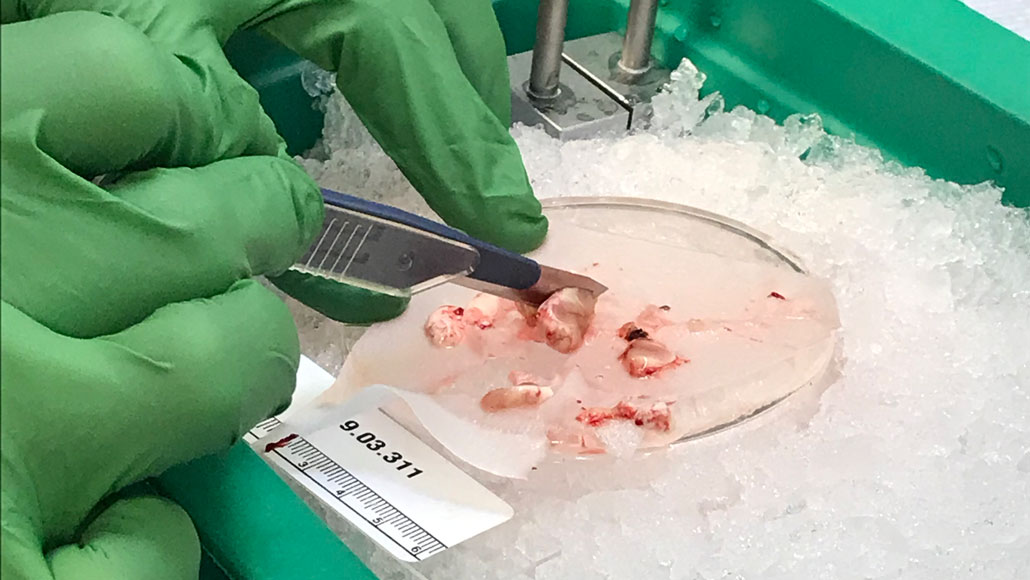Living brain tissue experiments raise new kinds of ethical questions
An ethicist describes the quandaries raised by working with tissue involved in our awareness

At the Allen Institute for Brain Science in Seattle, scientists prepare a piece of still-living brain tissue that was just removed during a surgery.
Molly Telfer
- More than 2 years ago
SEATTLE — Live bits of brain look like any other piece of meat — pinkish, solid chunks of neural tissue. But unlike other kinds of tissue or organs donated for research, they hold the memories, thoughts and feelings of a person.
“It is identified with who we are,” Karen Rommelfanger, a neuroethicist at Emory University in Atlanta, said February 13 in a news conference at the annual meeting of the American Association for the Advancement of Science. That uniqueness raises a whole new set of ethical quandaries when it comes to experimenting with living brain tissue, she explained.
Such donations are crucial to emerging research aimed at teasing out answers to what makes us human. For instance, researchers at the Seattle-based Allen Institute for Brain Science conduct experiments on live brain tissue to get clues about how the cells in the human brain operate (SN: 8/7/19). These precious samples, normally discarded as medical waste, are donated by patients undergoing brain surgery and raced to the lab while the nerve cells are still viable.
Other experiments rely on systems that are less sophisticated than a human brain, such as brain tissue from other animals and organoids. These clumps of neural tissue, grown from human stem cells, are still a long way from mimicking the complexities of the human brain (SN: 10/24/19). But with major advances, these systems might one day be capable of much more advanced behavior, which might ultimately lead to awareness, a conundrum that raises ethical issues.
To avoid just that kind of issue in animal studies, scientists studying cellular activity in dead pig brains raised the remote possibility of the rejuvenated brain tissue having a sliver of awareness (SN: 4/17/19). So widespread neural activity in these pig brains were preemptively blocked, and researchers watched for any signs of consciousness. Protocols were in place to stop the experiment if those signals were observed.
Rommelfanger spoke during the news conference and later with Science News about the ethical considerations that she argues should accompany neuroscience research. Her answers have been edited for brevity and clarity.
SN: Is there something special about the brain, or is it an organ like any other?

Rommelfanger: The whole reason that the field I work in, neuroethics, exists is because there does seem to be something culturally important about the human brain, that it is identified with who we are…. The brain is not considered an organ, because it’s something, at this point, that you can’t donate. Until we can, it’s in a total separate category, which also shows its exceptionalism.
SN: How were ethicists involved in the pig brain experiment?
Rommelfanger: That wasn’t ethics as an afterthought…. We did a couple of years of consulting with [researchers]. And of course we are still carefully watching that project and working with the researchers where we can.
SN: How close is too close when it comes to systems that mimic the human brain?
Rommelfanger: The reason we’re creating new models is because nonhuman animal models often fall short as proxies of the human brain. So we have ourselves in an ethical conundrum: The closer these approximations get to the human brain and the more fidelity we have to that, the more ethically fraught it becomes.
SN: How much is too much when it comes to working with patients’ living brain tissue?
Rommelfanger: This is a question of incrementalism: How much brain do you take before you freak out? We will have crossed the line if we have something that we are able to measure that has some sort of independent awareness on its own. That’s a really extreme scenario that I’m operating with. But I don’t think we should wait until we get really close to something like that to [consider the ethics].
SN: Should volunteers help shape how brain research proceeds?
Rommelfanger: I think new research directions [in areas such as brain donation, neural implants or organoids grown from volunteers’ stem cells] can be pushed by patients. More creativity comes from the more backgrounds we have in the room. Even if it seems outlandish, you never know. It could spawn some really great ideas.






